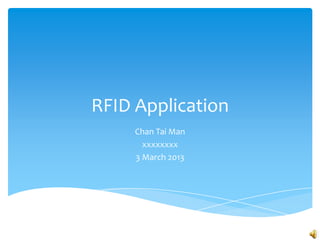
Sample pss7
- 1. RFID Application Chan Tai Man xxxxxxxx 3 March 2013
- 2. Contents Future Introduction Survey development Applications Conclusion of RFID Results and opportunities
- 3. RFID RFID = Radio Frequency Identification Electronic labeling and wireless identification of objects using radio frequency Tag carries with its information a serial number Model number Color or any other imaginable data When these tags pass through a field generated by a compatible reader, they transmit this information back to the reader, thereby identifying the object
- 4. RFID components A basic RFID system consists of these components: A programmable RFID tag/inlay for storing item data; consisting of an RFID chip for data storage an antenna to facilitate communication with the RFID chip A reader/antenna system to interrogate the RFID inlay Application software and a host computer system
- 5. RFID Tag The RFID tag consists of an integrated circuit (IC) embedded in a thin film medium. Information stored in the memory of the RFID chip is transmitted by the antenna circuit embedded in the RFID inlay via radio frequencies, to an RFID reader 3 types Passive Semi-passive Active
- 6. Types of RFID Tags Active Tags Semi-passive Tags Passive Tags •Use a battery •Contain built-in •Derive their power •communicate over batteries to power from the field distances of several the chip’s generated by the meters circuitry, resist reader interference and •without having an circumvent a lack of active transmitter to power from the transfer the reader signal due to information stored long distance. •They are different from active tags in that they only transmit data at the time a response is received
- 7. Applications Frequency Appx. Read Range Data Speed Cost of Tags Application Low Frequency (125kHz) <5cm Low High • Animal Identification (passive) • Access Control High Frequency (13.56 Mhz) 10 cm – 1m Low to Moderate Medium to Low • Smart Cards (passive) • Payment (paywave) Ultra High Frequency (433, 868-928 Mhz) 3m -7m Moderate to High Low • Logistics and Supply Chain (passive) • Baggage Tracking Microwave (2.45 & 5.8 Ghz) 10m -15m High High • Electronic toll collection (Autotoll) (passive) • Container Tracking 20m – 40m (active)
- 9. Applications Credit Cards with RFID (Paywave function) Octopus (Smart Card)
- 10. Applications Autotoll (Electronic toll collection) Access Control
- 11. Online Survey Target: SME Information: Opinion on RFID and its applications Site: http://qtrial.qualtrics.com/SE/?SID=SV_9N5UPRZuyuWts k4
- 12. Survey Result Types of industries that respondents think it is possible to apply RFID technology Document Management 8% Inventory Control 10% Security Customer Services 8% 5% Library Management Hotel Management 21% Other 5% 18% Pharmaceutic Banking and Finance manufacturing industries 5% 15% Social Services Logistics and Supply Chain 3% Management 20%
- 13. Further Development In medical uses and library management
- 14. Video
- 15. Conclusion Positive RFID is a contactless reading technology and can read through other materials Hold more data than barcode does RFID tags data can be changed or added More effective, bring lots of convenience to us Negative Cost is relatively remain high (compare to barcode) RFID signals may have problems with some materials RFID standards are still being developed